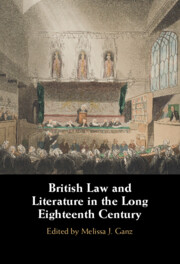Refine search
Actions for selected content:
325 results
1 - The Emerging Crisis (to December 1964)
-
- Book:
- Waging Peace
- Published online:
- 03 November 2025
- Print publication:
- 13 November 2025, pp 8-38
-
- Chapter
- Export citation
Constitutional subjects: the formation and fracture of constitutional legitimacy. Towards a phenomenology of law and violence
-
- Journal:
- European Law Open ,
- Published online by Cambridge University Press:
- 10 November 2025, pp. 1-25
-
- Article
-
- You have access
- Open access
- HTML
- Export citation
Private Right and Public Right
-
- Journal:
- Canadian Journal of Law & Jurisprudence , First View
- Published online by Cambridge University Press:
- 24 October 2025, pp. 1-13
-
- Article
-
- You have access
- Open access
- HTML
- Export citation
Introduction
-
-
- Book:
- British Law and Literature in the Long Eighteenth Century
- Published online:
- 19 September 2025
- Print publication:
- 09 October 2025, pp 1-24
-
- Chapter
- Export citation
8 - Plurinational Juristocracy and Rights from Below at Bolivia’s Gas Frontier
-
-
- Book:
- Reckoning with Law in Excess
- Published online:
- 09 September 2025
- Print publication:
- 25 September 2025, pp 186-211
-
- Chapter
-
- You have access
- Open access
- HTML
- Export citation

British Law and Literature in the Long Eighteenth Century
-
- Published online:
- 19 September 2025
- Print publication:
- 09 October 2025
Abstraction and Determination in Weinrib’s Reciprocal Freedom: The Dynamics of Backward-Looking and Forward-Looking Deliberation in Judging
-
- Journal:
- Canadian Journal of Law & Jurisprudence , First View
- Published online by Cambridge University Press:
- 09 September 2025, pp. 1-10
-
- Article
-
- You have access
- Open access
- HTML
- Export citation
How Capacious is the Kantian System of Rights?
-
- Journal:
- Canadian Journal of Law & Jurisprudence , First View
- Published online by Cambridge University Press:
- 09 September 2025, pp. 1-13
-
- Article
-
- You have access
- Open access
- HTML
- Export citation
The Deliberative Democratic Turn In Human Rights
- Part of
-
- Journal:
- Federal Law Review / Volume 53 / 2025
- Published online by Cambridge University Press:
- 03 September 2025, e1
-
- Article
-
- You have access
- Open access
- HTML
- Export citation
The Place of Federalism in Deliberative Rights Theory
- Part of
-
- Journal:
- Federal Law Review / Volume 53 / 2025
- Published online by Cambridge University Press:
- 03 September 2025, e5
-
- Article
-
- You have access
- Open access
- HTML
- Export citation
Chapter VI - A Right to the Truth in Another?
-
- Book:
- Kant and the Supposed Right to Lie
- Published online:
- 18 July 2025
- Print publication:
- 28 August 2025, pp 98-106
-
- Chapter
- Export citation
Chapter 10 - Karl Marx
-
- Book:
- Freedom and Perfection
- Published online:
- 25 July 2025
- Print publication:
- 14 August 2025, pp 284-318
-
- Chapter
- Export citation
12 - The Conceptual Foundations of Contract Formation
- from Part III - Reinach and Legal Concepts
-
-
- Book:
- Reinach and the Foundations of Private Law
- Published online:
- 20 July 2025
- Print publication:
- 07 August 2025, pp 305-328
-
- Chapter
-
- You have access
- Open access
- HTML
- Export citation
8 - The Ontology of Liberties
- from Part II - Reinach and Private Law Theory
-
-
- Book:
- Reinach and the Foundations of Private Law
- Published online:
- 20 July 2025
- Print publication:
- 07 August 2025, pp 189-216
-
- Chapter
-
- You have access
- Open access
- HTML
- Export citation
6 - Private Law beyond the Law
- from Part II - Reinach and Private Law Theory
-
-
- Book:
- Reinach and the Foundations of Private Law
- Published online:
- 20 July 2025
- Print publication:
- 07 August 2025, pp 150-165
-
- Chapter
-
- You have access
- Open access
- HTML
- Export citation
4 - Co-ownership and Neighbour Relations
-
- Book:
- Property Law in China
- Published online:
- 09 July 2025
- Print publication:
- 24 July 2025, pp 98-125
-
- Chapter
- Export citation
5 - From the Ghetto to the Gallows: Rights, Race, Class, and Drug Crimes in Malaysia
- from Part II - People on Death Row
-
-
- Book:
- Capital Drug Laws in Asia
- Published online:
- 07 August 2025
- Print publication:
- 24 July 2025, pp 111-134
-
- Chapter
- Export citation
5 - Political Legitimacy as Evaluation and Judgment
- from Part II - Political Legitimacy and Theory of Politics
-
- Book:
- The Law and Politics of International Legitimacy
- Published online:
- 14 July 2025
- Print publication:
- 24 July 2025, pp 68-91
-
- Chapter
- Export citation
Supreme Court Impacts in Public Health Law: 2024-2025
-
- Journal:
- Journal of Law, Medicine & Ethics ,
- Published online by Cambridge University Press:
- 10 July 2025, pp. 1-4
-
- Article
-
- You have access
- Open access
- HTML
- Export citation
5 - In the Flesh
-
- Book:
- After Equality
- Published online:
- 19 June 2025
- Print publication:
- 03 July 2025, pp 149-174
-
- Chapter
- Export citation
